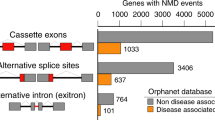Abstract:
Antisense technology has been used to study basic biological processes, and to block these processes when they deleteriously lead to human disease. A separate, equally important application of antisense technology is to upregulate the gene expression lost in the diseased state by shifting alternative splicing of pre-messenger RNA. This strategy has commonly relied upon the use of antisense oligonucleotides; however, another approach is to use a plasmid construct to generate antisense RNA inside the cell. Antisense therapeutics based on expression vectors and viral vectors offers a gene therapy approach, whereas those based on oligonucleotides offers a more drug like approach.
Similar content being viewed by others
Author information
Authors and Affiliations
Additional information
RID="*"
ID="*"Corresponding author.
Rights and permissions
About this article
Cite this article
Vacek, M., Sazani, P. & Kole, R. Antisense-mediated redirection of mRNA splicing. CMLS, Cell. Mol. Life Sci. 60, 825–833 (2003). https://doi.org/10.1007/s00018-003-3042-7
Issue Date:
DOI: https://doi.org/10.1007/s00018-003-3042-7




